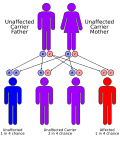Sugarman syndrome
(Redirected from Oral-facial-digital syndrome type 3)
| Sugarman syndrome | |
|---|---|
| autorecessive.svg | |
| Synonyms | N/A |
| Pronounce | N/A |
| Specialty | N/A |
| Symptoms | Ichthyosis, Hypogonadism, Short stature |
| Complications | N/A |
| Onset | Childhood |
| Duration | Lifelong |
| Types | N/A |
| Causes | Genetic mutation |
| Risks | N/A |
| Diagnosis | Genetic testing, Clinical evaluation |
| Differential diagnosis | N/A |
| Prevention | N/A |
| Treatment | Symptomatic treatment, Hormone therapy |
| Medication | N/A |
| Prognosis | Variable |
| Frequency | N/A |
| Deaths | N/A |
Sugarman syndrome is a rare genetic disorder characterized by a combination of ichthyosis, hypogonadism, and short stature. It is inherited in an autosomal recessive pattern, meaning that an individual must inherit two copies of the mutated gene, one from each parent, to be affected by the condition.
Presentation
Individuals with Sugarman syndrome typically present with symptoms in childhood. The hallmark features include:
- Ichthyosis: A condition characterized by dry, scaly skin. The severity can vary, and it often requires regular moisturizing and skin care.
- Hypogonadism: Underdevelopment of the gonads, leading to reduced levels of sex hormones. This can result in delayed or absent puberty and may require hormone replacement therapy.
- Short stature: A significantly shorter height than average for the individual's age and sex. Growth hormone therapy may be considered in some cases.
Genetics
Sugarman syndrome is caused by mutations in a specific gene, though the exact gene responsible has not been definitively identified. The condition follows an autosomal recessive inheritance pattern, as depicted in the accompanying image.
Diagnosis
Diagnosis of Sugarman syndrome is based on clinical evaluation and genetic testing. A detailed family history and physical examination are crucial. Genetic testing can confirm the diagnosis by identifying mutations in the suspected gene.
Management
There is no cure for Sugarman syndrome, and treatment is primarily symptomatic. Management strategies include:
- Regular skin care to manage ichthyosis
- Hormone replacement therapy for hypogonadism
- Growth hormone therapy for short stature, if indicated
Prognosis
The prognosis for individuals with Sugarman syndrome varies depending on the severity of symptoms and the effectiveness of management strategies. With appropriate care, individuals can lead relatively normal lives.
Also see
| Genetic disorders relating to deficiencies of transcription factor or coregulators | ||||||||||||||||||||||||||||||||||
|---|---|---|---|---|---|---|---|---|---|---|---|---|---|---|---|---|---|---|---|---|---|---|---|---|---|---|---|---|---|---|---|---|---|---|
|
Transform your life with W8MD's budget GLP-1 injections from $125.
W8MD offers a medical weight loss program to lose weight in Philadelphia. Our physician-supervised medical weight loss provides:
- Most insurances accepted or discounted self-pay rates. We will obtain insurance prior authorizations if needed.
- Generic GLP1 weight loss injections from $125 for the starting dose.
- Also offer prescription weight loss medications including Phentermine, Qsymia, Diethylpropion, Contrave etc.
NYC weight loss doctor appointments
Start your NYC weight loss journey today at our NYC medical weight loss and Philadelphia medical weight loss clinics.
- Call 718-946-5500 to lose weight in NYC or for medical weight loss in Philadelphia 215-676-2334.
- Tags:NYC medical weight loss, Philadelphia lose weight Zepbound NYC, Budget GLP1 weight loss injections, Wegovy Philadelphia, Wegovy NYC, Philadelphia medical weight loss, Brookly weight loss and Wegovy NYC
|
WikiMD's Wellness Encyclopedia |
| Let Food Be Thy Medicine Medicine Thy Food - Hippocrates |
Medical Disclaimer: WikiMD is not a substitute for professional medical advice. The information on WikiMD is provided as an information resource only, may be incorrect, outdated or misleading, and is not to be used or relied on for any diagnostic or treatment purposes. Please consult your health care provider before making any healthcare decisions or for guidance about a specific medical condition. WikiMD expressly disclaims responsibility, and shall have no liability, for any damages, loss, injury, or liability whatsoever suffered as a result of your reliance on the information contained in this site. By visiting this site you agree to the foregoing terms and conditions, which may from time to time be changed or supplemented by WikiMD. If you do not agree to the foregoing terms and conditions, you should not enter or use this site. See full disclaimer.
Credits:Most images are courtesy of Wikimedia commons, and templates, categories Wikipedia, licensed under CC BY SA or similar.
Contributors: Prab R. Tumpati, MD

